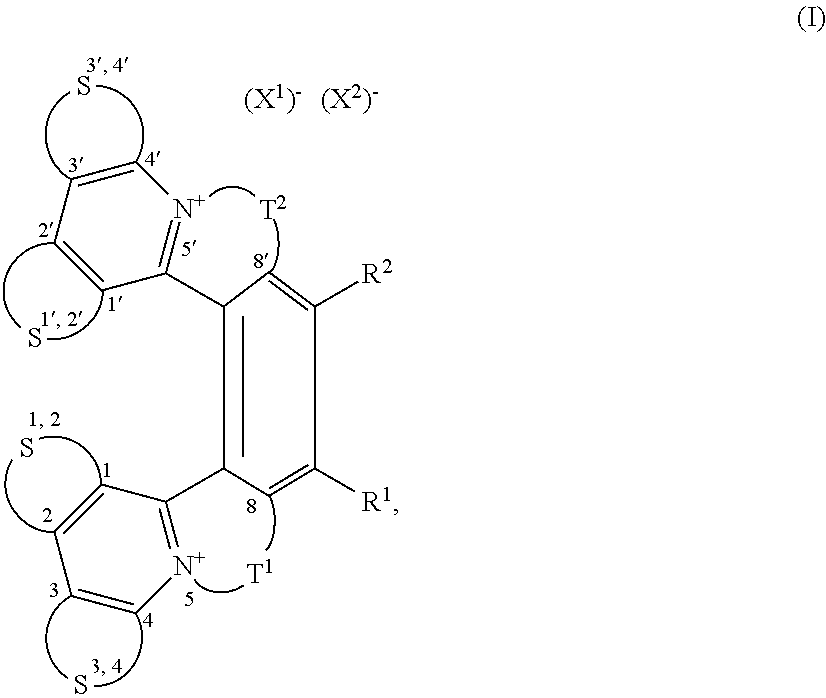Helquats with heteroaromatic substituents, preparation thereof, and use thereof as G-quadruplex stabilizers
a technology of heteroaromatic substituents and helquats, which is applied in the field of helquats with heteroaromatic substituents, can solve the problems of low selectivity of this particular compound towards g-quadruplex, telomere destabilization, and perturbation of the normal functioning of these proteins, so as to improve the expression of c-myc protein, inhibit expression, and the effect of high ability of helquats
- Summary
- Abstract
- Description
- Claims
- Application Information
AI Technical Summary
Benefits of technology
Problems solved by technology
Method used
Image
Examples
example 1
(rac)-(E)-13-(2-(dibenzo[b,d]furan-4-yl)vinyl)-6,7-dimethyl-4,5,8,9-tetrahydroisoquinolino[1,2-a]pyrido[1,2-k][2,9]phenanthroline-3,10-diium trifluoromethanesulfonate, MJA-C13-8
[0152]Starting helquat A (40 mg, 1 equiv, 59 μmol), dibenzo[b,d]furan-4-carbaldehyde (60 mg, 5 equiv, 306 μmol), pyrrolidine (30 mg, 35 μl, 7 equiv, 419 μmol) and dry methanol (1 ml) were placed into a 5 ml flask and the resulting mixture was stirred under argon for 2 h at room temperature. Progress of the reaction was monitored by thin layer chromatography. The crude product was precipitated from the reaction mixture by addition of diethylether (40 ml). The suspension was centrifuged and the liquid was separated from the solid pellet. The solids were partially dissolved in methanol (3 ml), the resulting mixture was mixed and the solubilized product was precipitated by addition of diethylether (40 ml). Then, this suspension was centrifuged, the liquid part was removed and this cleaning procedure was repeated ...
example 2
(rac)-(E)-13-(2-(9-ethyl-9H-carbazol-3-yl)vinyl)-6,7-dimethyl-4,5,8,9-tetrahydroisoquinolino[1,2-a]pyrido[1,2-k][2,9]phenanthroline-3,10-diium trifluoromethanesulfonate, MJA-C15-1
[0155]Starting helquat A (100 mg, 1 equiv, 148 μmol), 9-ethyl-9H-carbazole-3-carbaldehyde (66 mg, 2 equiv, 296 μmol), pyrrolidine (74 mg, 86 μl, 7 equiv, 1.035 mmol) and dry methanol (1 ml) were placed into a 5 ml flask and the resulting mixture was stirred under argon for 2 h at room temperature. Progress of the reaction was monitored by thin layer chromatography. The crude product was precipitated from the reaction mixture by addition of diethylether (40 ml). The suspension was centrifuged and the liquid was separated from the solid pellet. The solids were partially dissolved in methanol (5 ml), the resulting mixture was mixed and the solubilized product was precipitated by addition of diethylether (40 ml). Then, this suspension was centrifuged, the liquid part was removed and this cleaning procedure was ...
example 3
(rac)-8,9-dimethyl-2,13-bis((E)-2-(thiophen-3-yl)vinyl)-6,7,10,11-tetrahydrodipyrido[2,1-a:1′,2′-k][2,9]phenanthroline-5,12-diium trifluoromethanesulfonate, MJB-C5-9
[0158]Starting helquat M (40 mg, 1 equiv, 62 μmol), thiophene-3-carbaldehyde (210 mg, 30 equiv, 1.873 mmol), pyrrolidine (67 mg, 78 μl, 15 equiv, 937 μmol) and dry methanol (1 ml) were placed into a 5 ml flask and the resulting mixture was stirred under argon for 12 h at room temperature. Progress of the reaction was monitored by thin layer chromatography. The crude product was precipitated from the reaction mixture by addition of diethylether (40 ml). The suspension was centrifuged and the liquid was separated from the solid pellet. The solids were partially dissolved in methanol (5 ml), the resulting mixture was mixed and the solubilized product was precipitated by addition of diethylether (40 ml). Then, this suspension was centrifuged, the liquid part was removed and this cleaning procedure was repeated two more times...
PUM
| Property | Measurement | Unit |
|---|---|---|
| temperature | aaaaa | aaaaa |
| volume | aaaaa | aaaaa |
| temperature | aaaaa | aaaaa |
Abstract
Description
Claims
Application Information
 Login to View More
Login to View More - R&D
- Intellectual Property
- Life Sciences
- Materials
- Tech Scout
- Unparalleled Data Quality
- Higher Quality Content
- 60% Fewer Hallucinations
Browse by: Latest US Patents, China's latest patents, Technical Efficacy Thesaurus, Application Domain, Technology Topic, Popular Technical Reports.
© 2025 PatSnap. All rights reserved.Legal|Privacy policy|Modern Slavery Act Transparency Statement|Sitemap|About US| Contact US: help@patsnap.com



